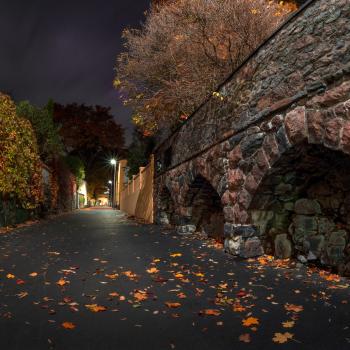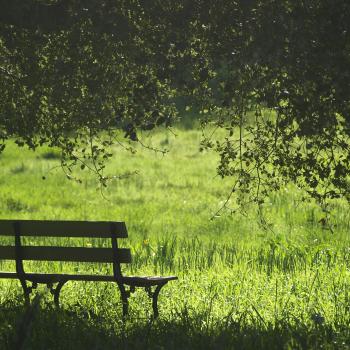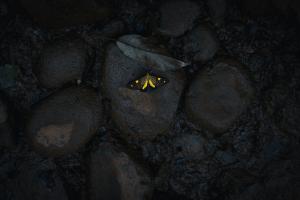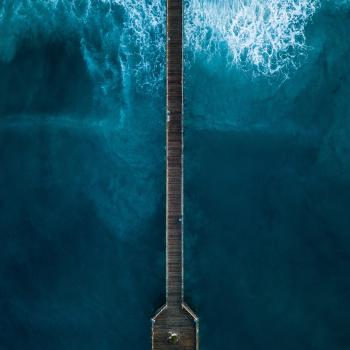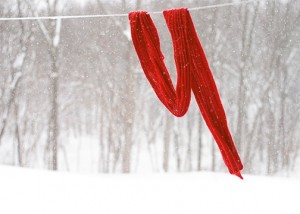 What a joy to be knitting something beautiful for a woman I don’t know and never will.
What a joy to be knitting something beautiful for a woman I don’t know and never will.
She’s a guest at my church’s soup kitchen, where every guest gets a gift at Christmastime.
The yarns are a rich red and orange wool interlaced with red-orange nylon eyelash.
She’ll say “how pretty —at least I hope she will.
Maybe it will become her favorite scarf,
make her feel special, dressy, worthy in a way that the world doesn’t usually value her.
But maybe she’ll leave it by mistake on the bus,
where it will ride up and down town alone on the seat
until a quick turn slides it to the floor.
The next passenger doesn’t notice it caught in his boot as he steps off the bus.
The red-orange lies limp in the gutter’s blackened snow.
A child walking by with her mother points with “Oh look! Can I have it?”
“No, we don’t take dirty things from the street.”
The lines above came to me unbidden one evening. I’d been knitting the scarf described, then put my knitting aside and picked up a poetry book from the table next to me. It was the collection Repair, by C. K. Williams. I read a couple of the poems, luxuriating in their lengthening lines that trace an ordinary event until it becomes extraordinary.
Then I closed the book, sat musing, and heard the above lines in my mind.
Long, long ago, when I used to go right to my desk after breakfast, I’d choose for breakfast reading a writer whose style I hoped would influence (literally: flow into) mine. The idea was that the rhythms and tone of this writer would reverberate into my own prose as I moved from the breakfast table to my desk.
For a while I chose Proust, but then my sentences got much too long, twining around a central memory of a sensuous experience from my childhood, then reaching further back — or forward — to encircle the larger scene of that memory, circling on and on and on (like this sentence).
Then I tried Chesterton, but my tone got too self-consciously paradoxical: gravely pondering the joyful lightness of God’s grace, or lightly treating the gravity of our human fall from grace.
Then I tried Virginia Woolf’s novels, but I’d get sucked in the stream of perceptions rushing down the crevices in my mind, racing to find words for the perceptions and forgetting to stop and give the reader a referent to what I was perceiving.
I never tried the Bible. I think that’s because D. H. Lawrence modeled his prose on biblical tropes, and I’ve never liked his novels.
I wonder when I stopped this practice of breakfast reading for the sake of my prose style. I guess eventually I got confident enough to write without a prompt.
Or maybe it was when the Internet came along. After breakfast and Morning Prayer, I do still go to my computer. But first I check my email, then I turn to whatever writing project I’m working on. I hardly want email to act as a model for my prose! Though it would be better than using Twitter. (Or, to say this in tweetspeak: “Nix email as prose model, tho tweets worse.”)
Truly, though, imitating the great masters has long been a way to learn one’s craft. Art students used to be sent to the museum to copy a great painting — so that the painter’s vision and brush strokes would be internalized in the novice’s brain waves and muscle memory.
And I have often suggested to poetry students that they read a certain poet to see how she or he puts a poem together. So, for instance, if my student is trying to write formal verse, I’ll suggest Mark Jarman’s Unholy Sonnets. Or if the student is attracted to the natural world as a subject, I’ll suggest the poetry of Luci Shaw or Todd Davis.
Or if the student wants to write free verse, I’ll say (gently) that free verse is not simply prose broken into arbitrary line breaks; I’ll suggest reading Denise Levertov’s poetry, along with her essays on form (like “Some Notes on Organic Form” or “Linebreaks, Stanza-Spaces, and the Inner Voice”).
Whatever art form we practice, our art emerges in a continuum with all that has gone before it. The Romantic era celebrated “originality,” but there’s really no such thing. An entirely original work of art would be incomprehensible.
Take the music of John Cage. My favorite is called “4’33” or “Four Minutes Thirty-three Seconds.” It can be for any instrument, since the instrument is not touched during the work. I remember attending a performance. A pianist came out, sat at the piano, kept her hands on her lap… and the minutes went by. The audience started to squirm, then eventually to giggle. All our expectations of “performance” were being unfulfilled.
Yet as unconventional as Cage’s work is, it’s still in the continuum of Western music. It starts with the tradition, then deliberately subverts traditional expectations. Without our conventional experience of performance, Cage’s work would make no sense.
I’m grateful to be writing in a tradition. If I went back now to my breakfast reading for inspiration habit, whom would I read? Rowan Williams for his prose of sharp insights humbly presented; Annie Dillard for her poetic prose; Augustine’s Confessions for theological ponderings in a colloquial voice. And, certainly, my fellow “Good Letters” bloggers for their thoughtful joy in crafting the personal essay. In fact, their posts are where —after breakfast and Morning Prayer—I do begin my writing day.
Peggy Rosenthal is director of Poetry Retreats and writes widely on poetry as a spiritual resource. Her books include Praying through Poetry: Hope for Violent Times(Franciscan Media), and The Poets’ Jesus (Oxford). SeeAmazon for full list. She also teaches an online course, “Poetry as a Spiritual Practice,” through Image’s Glen Online program.


